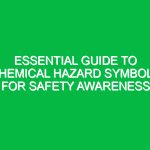Welcome team! Today, we are going to discuss an important topic that directly impacts your safety at work – Burn Severity. Understanding the severity of burns and how to prevent them is crucial for maintaining a safe and secure working environment. Let’s delve into the details to ensure that everyone is well-informed and prepared to mitigate any potential risks.
What is Burn Severity?
Burn Severity refers to the extent of damage caused by a burn injury. In the context of health, safety, and environment (HSE), understanding burn severity is essential for identifying potential hazards, assessing risks, and implementing preventive measures to protect workers from harm.
When it comes to occupational hazards, burns can result from various sources such as hot surfaces, chemicals, electricity, or flames. The severity of a burn is typically categorized into degrees, ranging from first-degree burns that affect the outer layer of skin to third-degree burns that penetrate deep into tissues.
Importance of Addressing Burn Severity
Recognizing and addressing burn severity is critical for several reasons:
- Preventing Injuries: By understanding the severity of burns, workers can take appropriate precautions to avoid accidents and injuries.
- Promoting Safety: Knowledge of burn severity helps in creating a safe work environment and reducing the likelihood of workplace incidents.
- Minimizing Damage: Prompt identification of burn severity allows for timely intervention, minimizing the extent of injuries and facilitating effective treatment.
Identifying Burn Severity Risks
It is essential to be aware of potential burn severity risks in the workplace. Some common hazards include:
- Hot Surfaces: Contact with hot equipment or machinery can cause burns of varying degrees.
- Chemical Exposure: Contact with corrosive chemicals can result in severe burns.
- Electrical Hazards: Electric shocks can lead to thermal burns, affecting internal tissues.
By recognizing these risks and understanding the severity of burns they can cause, workers can proactively protect themselves and their colleagues from harm.
Best Practices for Burn Severity Prevention
Here are some best practices to prevent burns and address burn severity effectively:
- Use Personal Protective Equipment (PPE): Wear appropriate protective gear, such as gloves, goggles, and flame-resistant clothing, to reduce the risk of burns.
- Follow Safety Procedures: Adhere to established safety protocols, including proper handling of equipment and materials to prevent burn injuries.
- Stay Informed: Educate yourself on the types of burns, their severity levels, and first aid measures to take in case of an incident.
Regulations and Compliance
It is important to comply with relevant regulations and standards related to burn severity in the workplace. By following established guidelines and protocols, you not only ensure your safety but also fulfill legal obligations that protect both employees and the organization.
Conclusion
Understanding burn severity is a crucial aspect of maintaining a safe work environment. By being informed about the risks, practicing preventive measures, and complying with regulations, we can collectively promote safety and well-being in our workplace. Remember, your safety is our top priority. Thank you for your attention and dedication to upholding safety standards.


